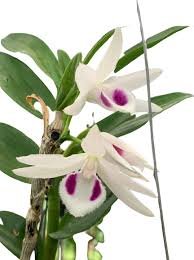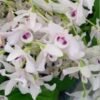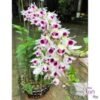### Tips for Growing Phalaenopsis Orchids in Low Light Conditions

Phalaenopsis orchids, or moth orchids, are known for their exquisite beauty and resilience, making them a favorite among both beginner and experienced gardeners. However, like most orchids, Phalaenopsis thrives in bright, indirect light, making it challenging to grow them successfully in low light conditions. This article provides essential tips and strategies to help Phalaenopsis orchids flourish in low light, allowing you to enjoy their beautiful blooms even in areas with limited sunlight.
#### Understanding the Light Needs of Phalaenopsis Orchids
Phalaenopsis orchids are generally adaptable but perform best under certain light conditions. In their natural habitat, they grow as epiphytes on trees, where they receive filtered sunlight through the forest canopy. This indirect light is bright but diffused, providing the orchids with the necessary energy for photosynthesis without exposing them to harsh sunlight. When grown indoors or in low light conditions, special attention is needed to replicate this environment and ensure the plants receive the light they need.
**Optimal Light Conditions for Phalaenopsis Orchids**:
1. **Medium to Bright Indirect Light**: Ideally, Phalaenopsis orchids thrive with medium to bright indirect light for about 10-12 hours a day.
2. **Avoid Direct Sunlight**: Direct sunlight can scorch the leaves, causing burn marks and stressing the plant.
3. **Adjusting to Low Light**: In low light conditions, Phalaenopsis orchids need special care to ensure they can photosynthesize effectively.
#### Signs of Insufficient Light in Phalaenopsis Orchids
Before delving into the tips for growing Phalaenopsis orchids in low light, it’s essential to recognize signs that indicate the plant isn’t getting enough light:
1. **Dark Green Leaves**: Although Phalaenopsis leaves are generally green, a very dark shade of green indicates insufficient light.
2. **Slow or No Flowering**: Orchids that don’t bloom within a year may be experiencing a lack of light.
3. **Weak, Leggy Growth**: When Phalaenopsis orchids don’t receive enough light, their leaves may grow long and thin in an attempt to reach for more light.
4. **No New Leaf Growth**: Limited or no new leaf growth can also signify that the orchid is not receiving enough light to fuel healthy development.
Once you’re able to identify these signs, you can take steps to improve the conditions, helping your orchid adapt to lower light levels.
#### 1. Choosing the Right Location for Low Light Conditions
Finding the ideal spot within your space is crucial when growing Phalaenopsis orchids in low light.
**Best Indoor Spots for Low Light**:
– **North-Facing Windows**: North-facing windows typically receive the least amount of direct sunlight, which is perfect for low light-loving plants. While the light may be limited, placing your Phalaenopsis orchid closer to the window can maximize what is available.
– **East-Facing Windows**: If you have an east-facing window, this spot can be beneficial since it receives gentle morning light, which is ideal for orchids. Position the plant a few feet from the window to prevent exposure to direct sunlight.
– **Rooms with Artificial Light**: Rooms with fluorescent or LED lighting can also serve as effective spots for orchids, particularly if natural light is insufficient. These lights can mimic sunlight and provide the necessary energy for photosynthesis.
#### 2. Using Artificial Grow Lights
When natural light is limited, artificial lighting can be a game-changer. Grow lights specifically designed for indoor plants can provide the spectrum of light Phalaenopsis orchids need to thrive.
**Types of Grow Lights**:
– **Fluorescent Lights**: Fluorescent tubes (especially T5 and T8) provide adequate lighting for orchids. They emit a cool light that is similar to natural sunlight and can be used for up to 12-16 hours a day.
– **LED Grow Lights**: LED grow lights are energy-efficient and can be tailored to emit the specific wavelengths of light that plants require. LEDs designed for indoor plants typically offer both blue and red spectrums, which are ideal for growth and flowering.
– **Compact Fluorescent Lights (CFL)**: CFLs are affordable options for small setups, like individual Phalaenopsis plants. They work best when placed close to the plant (about 6-12 inches away).
**How to Use Grow Lights**:
– **Positioning**: Place the lights 6-12 inches above the orchid, ensuring they cover the entire plant evenly.
– **Timing**: Orchids need 10-14 hours of light each day. Using a timer can help regulate the light exposure, mimicking natural day lengths.
– **Intensity**: Adjust the distance of the light based on your plant’s response. Leaves should remain a vibrant green color without darkening excessively or developing burn marks.
#### 3. Managing Humidity in Low Light Conditions
Phalaenopsis orchids thrive in high humidity, particularly when grown in low light, as this environment resembles their natural habitat. In low light, orchids may transpire less water, which can reduce the humidity around the plant.
**Tips for Maintaining Humidity**:
– **Use a Humidity Tray**: Place a shallow tray filled with water and pebbles beneath the orchid pot. The evaporation from the water will increase humidity around the plant.
– **Group Plants Together**: Grouping multiple plants together can create a mini-microclimate, increasing the surrounding humidity.
– **Invest in a Humidifier**: For areas with consistently low humidity, a humidifier can be beneficial. Aim for a humidity level of 50-70% for optimal growth.
#### 4. Adjusting Watering Practices for Low Light
In low light conditions, Phalaenopsis orchids typically require less water because they experience slower evaporation and lower rates of photosynthesis.
**Watering Guidelines**:
– **Water Less Frequently**: Reduce watering frequency compared to high-light conditions. Allow the potting medium to dry out slightly between waterings.
– **Check for Moisture**: Insert a finger into the potting medium to test for moisture before watering. The top inch should feel dry before re-watering.
– **Use Lukewarm Water**: Orchids are sensitive to temperature extremes. Lukewarm water can prevent cold shock, especially in cooler indoor environments.
#### 5. Choosing the Right Potting Medium
In low light, Phalaenopsis orchids benefit from a potting medium that allows for adequate drainage and aeration. Since lower light reduces evaporation, a well-draining medium helps prevent root rot.
**Recommended Potting Medium**:
– **Bark Mix**: Bark-based potting mixes are ideal for Phalaenopsis orchids as they provide ample airflow around the roots, which is crucial in low light.
– **Charcoal and Perlite**: Adding charcoal or perlite to the potting mix can improve drainage and prevent waterlogging.
– **Avoid Dense Soils**: Avoid soil-based or overly compact potting media, as these retain too much moisture, which can cause root rot in low light conditions.
#### 6. Fertilizing Orchids in Low Light
Fertilizer can provide Phalaenopsis orchids with essential nutrients needed for healthy growth, but in low light conditions, fertilizing needs to be adjusted to prevent overfeeding.
**Fertilizing Tips**:
– **Use a Balanced Orchid Fertilizer**: Choose a balanced fertilizer (e.g., 20-20-20) diluted to half or quarter strength to avoid over-fertilization.
– **Apply Less Frequently**: Fertilize every 4-6 weeks, rather than the standard 2-4 weeks recommended for orchids in higher light.
– **Flush the Potting Medium**: Once a month, rinse the potting medium with clear water to prevent salt buildup, which can harm orchid roots over time.
#### 7. Encouraging Flowering in Low Light
Low light conditions may reduce flowering potential, but with a few adjustments, you can still encourage your Phalaenopsis orchid to bloom.
**Techniques for Promoting Blooms**:
– **Cooler Night Temperatures**: Phalaenopsis orchids benefit from a temperature drop of about 10°F (5-6°C) at night, which stimulates flowering. Try moving the orchid to a cooler room at night.
– **Monitor Light Exposure**: Ensure the orchid receives 10-12 hours of light daily, even if it’s artificial. Consistent lighting is crucial for triggering the flowering cycle.
– **Nutrient Adjustments**: During the blooming season, switch to a fertilizer higher in phosphorus (e.g., 10-30-20) to support flower spike development.
#### 8. Recognizing Stress Signals
In low light, Phalaenopsis orchids can sometimes exhibit stress if conditions aren’t optimal. Recognizing stress signs early can help prevent further issues.
**Signs of Stress and Remedies**:
– **Yellowing Leaves**: Overwatering or inadequate light can cause yellowing. Adjust watering practices and ensure adequate light.
– **Wilting or Drooping Leaves**: If leaves are wilting, check for root rot, as it’s common in low light conditions with excess moisture.
– **Slow Growth**: Low light slows growth naturally, but excessive slowing may indicate a need for additional light.
#### Conclusion
Growing Phalaenopsis orchids in low light conditions can be a rewarding experience with the right approach. By carefully selecting the location, using artificial lighting, managing humidity, adjusting watering and fertilization practices, and promoting flowering, you can create an environment that allows your orchid to thrive. With patience and consistent care, your Phalaenopsis orchids will reward you with beautiful blooms and healthy foliage, even in spaces with limited natural light. Whether you’re working with a shaded room or a north-facing window, these tips will guide you in providing the best possible care for your
orchids.

